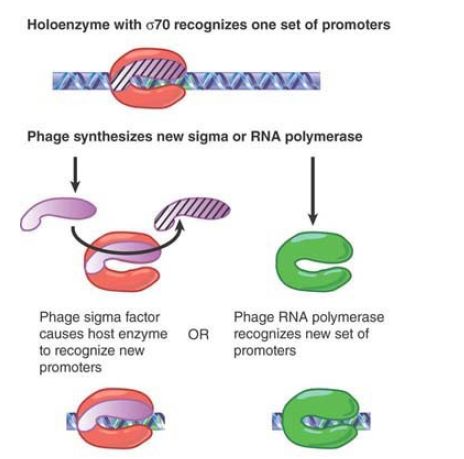


 النبات
النبات
 الحيوان
الحيوان
 الأحياء المجهرية
الأحياء المجهرية
 علم الأمراض
علم الأمراض
 التقانة الإحيائية
التقانة الإحيائية
 التقنية الحيوية المكروبية
التقنية الحيوية المكروبية
 التقنية الحياتية النانوية
التقنية الحياتية النانوية
 علم الأجنة
علم الأجنة
 الأحياء الجزيئي
الأحياء الجزيئي
 علم وظائف الأعضاء
علم وظائف الأعضاء
 الغدد
الغدد
 المضادات الحيوية
المضادات الحيوية|
Read More
Date: 24-12-2015
Date: 22-4-2021
Date: 29-11-2015
|
Two Types of Regulatory Events Control the Lytic Cascade
Key concept
- Regulator proteins used in phage cascades may sponsor initiation at new (phage) promoters or cause the host polymerase to read through transcription terminators.
At every stage of phage expression, one or more of the active genes is a regulator that is needed for the subsequent stage. The regulator may take the form of a new sigma factor that redirects the specificity of the host RNA polymerase or an antitermination factor that allows it to read a new group of genes . The following discussion compares the use of switching at initiation or termination to control gene expression.
One mechanism for recognizing new phage promoters is to replace the sigma factor of the host enzyme with another factor that redirects its specificity in initiation, as shown in FIGURE 1. An alternative is to synthesize a new phage RNA polymerase. In either case, the critical feature that distinguishes the new set of genes is their possession of different promoters from those originally recognized by host RNA polymerase.

FIGURE 1. A phage may control transcription at initiation either by synthesizing a new sigma factor that replaces the host sigma factor or by synthesizing a new RNA polymerase.
Antitermination provides an alternative mechanism for phages to control the switch from early genes to the next stage of expression. The use of antitermination depends on a particular arrangement of genes. the early genes lie adjacent to the genes that are to be expressed next, but are separated from them by terminator sites. If termination is prevented at these sites, the polymerase reads through into the genes on the other side. So in antitermination, the same promoters continue to be recognized by RNA polymerase. The new genes are expressed only by extending the RNA chain to form molecules that contain the early gene sequences at the 5′ end and the new gene sequences at the 3′ end. The two types of sequences remain linked; thus, early gene expression inevitably continues. The regulator gene that controls the switch from immediate early to delayed early expression in phage lambda is identified by mutations in gene N that can transcribe only the immediate early genes; they proceed no further into the infective cycle . From the genetic point of view, the mechanisms of
new initiation and antitermination are similar. Both are positive controls in which an early gene product must be made by the phage in order to express the next set of genes. By employing either sigma factor or antitermination proteins with different specifications, a cascade for gene expression can be constructed.



|
|
|
|
إجراء أول اختبار لدواء "ثوري" يتصدى لعدة أنواع من السرطان
|
|
|
|
|
|
|
دراسة تكشف "سببا غريبا" يعيق نمو الطيور
|
|
|
|
|
|
قسم الشؤون الفكرية يقيم برنامج (صنّاع المحتوى الهادف) لوفدٍ من محافظة ذي قار
|
|
|
|
الهيأة العليا لإحياء التراث تنظّم ورشة عن تحقيق المخطوطات الناقصة
|
|
|
|
قسم شؤون المعارف يقيم ندوة علمية حول دور الجنوب في حركة الجهاد ضد الإنكليز
|
|
|
|
وفد جامعة الكفيل يزور دار المسنين في النجف الأشرف
|